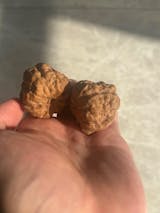The Meaning and Benefits of Mantra Mandala Thangka with 8 Auspicious Tibetan Symbols
- Introduction
- 1. What is Mantra Mandala Thangka?
- 2. What are the 8 Auspicious Tibetan Symbols?
- 3. What are the Meaning and Significance of Mantra in Tibetan Buddhism?
- 4. What are the Benefits of Meditating on Mantra Mandala Thangka Paintings
- Conclusion
Introduction
In the serene world of Tibetan art, the Mantra Mandala Thangka holds profound significance, offering a gateway to spiritual enlightenment and inner peace. In this post, let's explore the profound meaning and benefits of mantra mandala Thangka with 8 auspicious Tibetan symbols.

1. What is Mantra Mandala Thangka?
The Mantra Mandala Thangka is a sacred depiction found in Tibetan Buddhist art, characterized by its circular form and intricate design. It represents the universe and the interconnectedness of all beings, serving as a visual aid for meditation and contemplation.
2. What are the 8 Auspicious Tibetan Symbols?
The Parasol (གདུགས་མཆོག་): Symbolizing protection from harmful forces and obstacles, the parasol represents the umbrella of spiritual authority. It signifies the shelter and refuge provided by the teachings of the Buddha, shielding practitioners from the adversities of samsara.
The Golden Fishes (བུ་མོ་): Often depicted as a pair of intertwined fish, the golden fishes symbolize abundance, fertility, and liberation. They represent the auspiciousness of spiritual wealth and the freedom attained through the pursuit of enlightenment.
The Treasure Vase (བུད་མེད་): Also known as the vase of inexhaustible treasures, this symbol embodies the infinite wealth of the Buddhist teachings. It represents the abundance of spiritual virtues, wisdom, and merit, signifying the boundless treasures found within the teachings of the Dharma.
The Lotus Flower (པད་མ་): The lotus flower symbolizes purity, enlightenment, and spiritual growth. Despite growing in muddy waters, the lotus rises above the surface, untainted by impurities. It represents the journey from darkness to light, from ignorance to wisdom, and serves as a reminder of the potential for enlightenment within all beings.
The Conch Shell (དུང་གསལ་): The conch shell symbolizes the teachings of the Buddha, which resonate like the sound of the conch, spreading far and wide to dispel ignorance and awaken beings to the path of liberation. It also represents the victory of the Dharma over ignorance and the call to awaken beings to the truth.
The Endless Knot (དཔལ་བེའུ་): Also known as the eternal knot, this symbol represents the interconnectedness of all phenomena and the infinite wisdom of the Buddha's teachings. It symbolizes the interdependence of all things, the continuity of existence, and the cyclical nature of life, death, and rebirth.
The Victory Banner (རྒྱལ་མཚན་): The victory banner symbolizes the triumph of wisdom over ignorance and the victory of enlightenment over the forces of delusion. It represents the attainment of spiritual victory and the realization of one's true nature, free from the bonds of suffering and ignorance.
The Wheel of Dharma (ཁོང་རྒྱལ་): Also known as the Dharmachakra, this symbol represents the teachings of the Buddha and the path to enlightenment. It embodies the turning of the wheel of the Dharma, symbolizing the Buddha's first sermon and the dissemination of his teachings to guide beings towards liberation from suffering.
Each of these symbols holds deep spiritual significance and serves as a reminder of the path to enlightenment and the attainment of spiritual awakening. Together, they adorn the Mantra Mandala Thangka, infusing it with auspiciousness and blessings for all who behold it.

3. What are the Meaning and Significance of Mantra in Tibetan Buddhism?
At the heart of the Mantra Mandala Thangka lies the power of mantra – sacred chants or phrases that hold profound spiritual significance.
Tibetan Buddhist mantras are words originally spoken by a Buddha while deep in meditation. Reciting them helps to replace the endless, internal chatter of the mind with calming syllables that purify karmic imprints, bring beneficial energy, focus the concentration, and offer protection and blessings.
4. What are the Benefits of Meditating on Mantra Mandala Thangka Paintings
Meditating on the Mantra Mandala Thangka offers a multitude of benefits, each contributing to the practitioner's spiritual growth and well-being:
- 1. Enhanced Focus and Concentration
- 2. Deepening Spiritual Connection
- 3. Stress Reduction and Relaxation
- 4. Alignment of Chakras and Energy Centers
- 5. Cultivation of Compassion and Loving-Kindness
- 6. Visualization and Manifestation
- 7. Spiritual Protection and Blessings
- 8. Inner Transformation and Self-Realization
1. Enhanced Focus and Concentration:
By meditating on the intricate details and sacred geometry of the Mantra Mandala Thangka, practitioners cultivate a heightened sense of focus and concentration. This focused attention aids in calming the mind and cultivating mindfulness.
2. Deepening Spiritual Connection:
The Mantra Mandala Thangka serves as a visual representation of sacred mantras, deities, and spiritual principles. Meditating on the mandala deepens one's connection to these spiritual energies, fostering a sense of reverence and devotion.
3. Stress Reduction and Relaxation:
Engaging with the Mantra Mandala Thangka in meditation promotes relaxation and stress reduction. The intricate patterns and symmetrical designs of the mandala have a calming effect on the mind, allowing practitioners to enter a state of deep relaxation and inner peace.
4. Alignment of Chakras and Energy Centers:
The Mantra Mandala Thangka is often imbued with symbolic representations of the chakras and energy centers within the body. Meditating on the mandala helps to balance and align these energy centers, promoting overall health and well-being on physical, emotional, and spiritual levels.
5. Cultivation of Compassion and Loving-Kindness:
Many Mantra Mandala Thangkas feature depictions of bodhisattvas and enlightened beings embodying qualities of compassion and loving-kindness. Meditating on these images inspires practitioners to cultivate these virtues within themselves, fostering greater empathy, compassion, and altruism towards all beings.
6. Visualization and Manifestation:
Meditating on the Mantra Mandala Thangka involves visualization techniques that enable practitioners to manifest their intentions and aspirations. By focusing on specific symbols or mantras within the mandala, individuals can harness the power of their thoughts to manifest positive outcomes in their lives.
7. Spiritual Protection and Blessings:
The Mantra Mandala Thangka is often considered a sacred object imbued with spiritual protection and blessings. Meditating on the mandala invokes the blessings of enlightened beings and protective deities, creating a shield of spiritual protection around the practitioner and their environment.
8. Inner Transformation and Self-Realization:
Ultimately, meditating on the Mantra Mandala Thangka facilitates inner transformation and self-realization. Through regular practice, individuals can transcend limiting beliefs and egoic tendencies, awakening to their true nature and realizing the ultimate goal of enlightenment.

Conclusion:
Overall, the Mantra Mandala Thangka embodies the timeless wisdom of Tibetan Buddhism, offering seekers a glimpse into the profound mysteries of the universe and the boundless potential of the human spirit. Meditating on the Mantra Mandala Thangka is a transformative practice that nourishes the body, mind, and spirit, leading to profound personal growth and spiritual evolution.
Related Articles:
The Signficance and Benefits of Kalachakra Mandala Thangka Art

























































